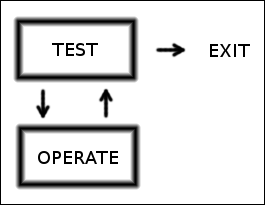Motivation and emotion/Book/2014/Fresh start effect
How are temporal landmarks used to demarcate time
and increase motivation?
Overview
[edit | edit source]
John is overweight and has unhealthy eating habits. He is in the process of trying to lose weight. He begins to try short-term diets and weight-loss programs such as limiting the types of foods he can eat and the portion sizes of his meals. John has not enjoyed any success. During Christmas, he and his family cook larger amounts of food. Around this time of year he usually gains a small amount of weight. This weight is often lost again, with his weight wavering between overweight and obese. John is in the habit of measuring his weight in kilograms, and calculates his BMI very occasionally. He, like many people, decides to have a New Years' resolution: to lose weight. He thinks that this behaviour will lead him to lose weight.
Kathy is an active, teenaged student who is an aspiring track and field athlete. She had recently completed rehabilitation for a knee injury she sustained the previous year, which did not effect her academic performance, but ended her athletic season. At the start of the new school term, she increases her already vigorous training schedule to six times a week for three hours, before she attends her school. Kathy and her coach decide that she will set a goal: run a 50 second 400m race, and achieve this by the end of the year. She thinks that her goal is achievable.
Defining the question
[edit | edit source]|
What are temporal landmarks? A temporal landmark is a point in time which stands out as important or meaningful to an individual or a group of individuals. (e.g., your 21st birthday, or your whereabouts during 9/11) |
What is demarcation? Demarcation refers to the action of creating boundaries. An example of this is a mark in time which signifies a period before or after an individual started trying to lose weight. |
Miller, Galanter and Pribram (1960) explained how individuals have ideal states of behaviour. This is a mental representation that can be incongruent with their current state of behaviour. The discrepancy between the current state and the ideal state can increase motivation in an individual. They formulated the idea that discrepancy can provide energy and direction for motivation, and the experience of discrepancy (also referred to as incongruity) is uncomfortable, resulting in an act to decrease it. Miller et al. (1960) termed this solution to incongruity as a spring to action, and said that we organise our behaviour to obtain the ideal state. In other words, discrepancy provides energy, which gives us direction. It is clear that it is not the ideal state that increases motivation, but that it is the discrepancy between the ideal and present states.
Locke and Latham (1990) discussed the incongruity between the present and ideal states of accomplishment as Goal-Performance Discrepancy.
TOTE model (Miller, et al., 1960)
[edit | edit source]
Test, Operate, Test, Exit. TOTE is a cognitive mechanism in which the present state is compared against the ideal state (Miller et al., 1960). This model emphasises the "O" as an operation on the environment. The "T" is a comparison, the "O" is a change, and the "E" is when the operation was sufficient to produce the ideal state. The model is designed to produce an ideal state after multiple testing phases. As the diagram shows, the order might be: Test, Operate, Test, Operate... Test, Exit. The Test phase is repeated until the ideal state is reached.
Time Perspective (Zimbardo and Boyd, 1999)
[edit | edit source]| “ | Time Perspective (TP) is the often nonconscious process whereby the continual flows of personal and social experiences are assigned to temporal categories, or time frames, that help to give order, coherence, and meaning to those events. (Zimbardo & Boyd, 1999) | ” |
Zimbardo and Boyd (1999) theorised that our experiences are organised into temporal chunks and that TP can change an individual's behaviour.
The five factors in the Zimbardo Time Perspective Inventory (ZTPI) are:
- Past-Negative - pessimistic, negative, or aversive attitude toward the past.
- Past-Positive - glowing, nostalgic, positive construction of the past
- Present-Fatalistic - fatalistic, helpless, and hopeless attitude toward the future and life
- Present-Hedonistic - orientation toward present enjoyment, pleasure, and excitement, without sacrifices today for rewards tomorrow
- Future - highly organized, ambitious goal seekers who felt pressed for time but were willing to sacrifice present enjoyment to achieve their career objectives
(Zimbardo & Boyd, 1999)
Zimbardo and Boyd (1999) also theorised a sixth factor, dividing the future-oriented factor into 'Life-goal oriented' and 'Transcendental Future'. They suggest that the ability to change between TP's can help optimise psychological and physical health, and societal functioning. This ability to avoid bias toward a single, non-adaptive TP and flexibly switch between TP's depending on the situation and the ask is defined as Balance.

Fresh start effect (Dai, Milkman & Riis, 2014)
[edit | edit source]Dai et al. (2014) appear to be the first to use the term Fresh start effect in a psychological paper. In this report, three studies were summarised regarding the increase in behaviours such as searching for diet information (study 1), gym visits (study 2) and commitments to pursue goals (study 3), around temporal landmarks. Dai et al. (2014) emphasise that although a New Year's resolution is most common, other temporal landmarks such as school terms, calendar months, even the start of a new week can be a fresh start for an individual. In the study, Dai et al. (2014) refer to the fresh start effect as an increase in the likelihood of engaging in aspirational behaviours. They conclude that goals are achieved from looking at the big picture, and that temporal landmarks help achieve this viewpoint. They also conclude that demarcation helps individuals to leave their mistakes in the past, and look forward to a brighter future. This is line with Zimbardo and Boyd (1999) Time perspective theory; with the past-negative and future goal-oriented time perspectives being included in Dai et al.'s (2014) fresh start effect hypothesis.
|
New Year's resolutions In 1972, Marlett and Kaplan studied New Year's resolutions in a university student sample (N = 70). Participants were divided into those who made a resolution about weight loss and those who made no resolution. The effectiveness of the participants' resolutions were monitored, and this was the focus of the study. Although no significant findings were reported between the two groups, and no effects for making a resolution or having someone monitor the progress of the resolution, this study did help us to begin to understand behaviour change, and the processes behind it. Marlett and Kaplan (1972) also concluded that the design of the study needed work, as recording the behaviour did not help control it. They suggested a continuous recording of behaviour to more effectively monitor it. |
Discrete progress markers Amir and Ariely (2008) studied how discrete progress markers (DPM's) affect goal performance. The results were that DPM's may decrease goal performance, but goal certainty is a more important factor. Amir and Ariely (2008) theorise that DPM's not only provide progress and reduce uncertainty, they more importantly form subgoals. Also, they discuss how task partitioning may decrease overall goal performance via:
|
|
Temporal landmarks and Organisation Peetz and Wilson (2013) summarised that temporal landmarks are used to separate and organise our lives, and that they structure our perception of time. They stated that relevance and importance of events can be altered by the temporal context of the event. Peetz and Wilson (2013) argued that temporal landmarks have an effect on identity and motivation and that, similar to the motivational theory of Miller et al., (1960) discrepancies between current and ideal states will be reduced. This happens when temporal landmarks exacerbate the perceived discrepancy (Peetz & Wilson, 2013), and is evidence that temporal landmarks can help increase motivation. This happens through increasing self-awareness of the discrepancy between the current state and the future ideal state. |
Temporal Landmarks and Memory
Shum (1998) studied how temporal landmarks are used to organise memory, to aid memory recall, and to assist with dating tasks. He used three 'landmark' events to study flashbulb memories, first experiences, and reference points. He suggested that temporal landmarks are closely linked to autobiographical memory processes in the brain, and that in recall and dating tasks, temporal landmarks are used. |
Conclusion
[edit | edit source]This chapter introduced John and Kathy, two fictional characters who used temporal landmarks to achieve their goals. They harnessed the power of a fresh start to assist them on this journey. Dai et al. (2014) showed us that motivation is increased when we look at the big picture, and leave our mistakes in the past. Marlett and Kaplan (1972) showed that New Year's resolutions are common, but that they are not the best method for goal completion. Amir and Ariely (2008) discussed discrete progress markers, and how they can both help and hinder goal performance, but the overall goal must be clear, without subgoals getting in the way. Peetz and Wilson (2012) showed us how temporal landmarks change our perception of time and our organisation of events. Shum (1998) also discussed temporal landmarks, and how memory is organised closely with temporal landmarks.
This chapter also introduced the TOTE model, which we can use to identify what present state we are in for any behaviour (weight, fitness, dieting, as well as mood, and social relations, etc.) and uncover discrepancies between our present state and our ideal state. We first test, then we do something about it (operate). Did it work (test)? No? Try Again! Yes? The ideal state has been reached (exit).
This chapter also discussed Zimbardo's Time Perspective Theory in which he urges us to be able to switch between different time perspectives, and to not be stuck in one time perspective.
The final question: Do you need to wait for a temporal landmark to achieve a change in behaviour or a goal? No we do not! Goals can be achieved without temporal landmarks. But take advantage of any fresh starts in your life to boost your motivation.
Test Your Learning
[edit | edit source]
See also
[edit | edit source]References
[edit | edit source]Amir, O., & Ariely, D. (2008). Resting on laurels: The effects of discrete progress markers as subgoals on task performance and preferences. Journal Of Experimental Psychology: Learning, Memory, And Cognition, 34(5), 1158-1171. doi:10.1037/a0012857
Dai, H., Milkman, K. L., and Riis, J. (2014) The Fresh Start Effect: Temporal Landmarks Motivate Aspirational Behavior. The Wharton School Research Paper No. 51.http://dx.doi.org/10.1287/mnsc.2014.1901
Locke, E. A., & Latham, G. P. (1990). A theory of goal setting and task performance. Englewood Cliffs, NJ: Prentice Hall. Retrieved: October 16, 2014. Retrieved from: http://books.google.com.au/books/about/A_Theory_of_Goal_Setting_Task_Performanc.html?id=MHR9AAAAMAAJ&redir_esc=y
Marlatt GA, Kaplan BE (1972) Self-initiated attempts to change behavior—A study of New Year’s resolutions. Psych. Rep. 30(1):123–131. doi: 10.2466/pr0.1972.30.1.123
Miller, GA, Galanter, E., & Pribram, KA (1960). Plans and the structure of behavior. New York: Holt, Rhinehart, & Winston. Retrieved: October 18, 2014. Retrieved from: http://books.google.com.au/books/about/Plans_and_the_structure_of_behavior.html?id=-tNOAAAAMAAJ&redir_esc=y
Peetz, J., & Wilson, A. E. (2012). The post-birthday world: Consequences of temporal landmarks for temporal self-appraisal and motivation. Journal Of Personality And Social Psychology, 104(2), 249-266. doi:10.1037/a0030477
Shum, M. S. (1998). The role of temporal landmarks in autobiographical memory processes. Psychological Bulletin, 124(3), 423-442. doi:10.1037/0033-2909.124.3.423
Zimbardo, P. G., & Boyd, J. N. (1999). Putting time in perspective: A valid, reliable individual-differences metric. Journal Of Personality And Social Psychology, 77(6), 1271-1288. doi:10.1037/0022-3514.77.6.1271
External Links
[edit | edit source]- Philip Zimbardo prescribes a healthy take on time (Philip Zimbardo, 6:31 min, TED talk, 2009)
- http://www.thetimeparadox.com/zimbardo-time-perspective-inventory
